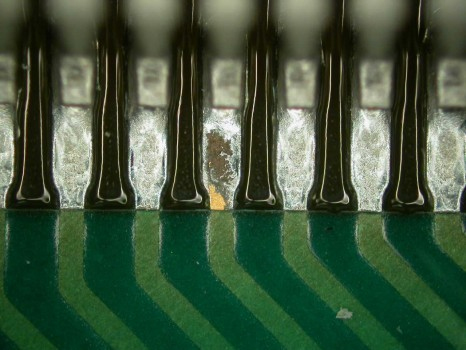 Solder flux is a very popular name in electronics industry and known to most of the electronic professionals. Flux is a chemical agent used extensively to ensure smooth flow of solder on the metal joints. The main purpose of using flux however is to remove oxidized metal from the surfaces to be soldered, seal out air thus preventing further oxidation, and by facilitating mixing it improves wetting characteristics of the solder. A chemical agent that aid so much in the process of soldering, what makes it so bad about flux then? Answer: The flux residue.
Solder flux is a very popular name in electronics industry and known to most of the electronic professionals. Flux is a chemical agent used extensively to ensure smooth flow of solder on the metal joints. The main purpose of using flux however is to remove oxidized metal from the surfaces to be soldered, seal out air thus preventing further oxidation, and by facilitating mixing it improves wetting characteristics of the solder. A chemical agent that aid so much in the process of soldering, what makes it so bad about flux then? Answer: The flux residue.
The flux residue is a flux leftover that is left on PCB after soldering. Apart from the board aesthetics one of the main reason why you should clean flux from your board is that it causes low voltage insulation short that can prevail (if not cleaned) between the pins of an IC where it was applied. Yes, flux left between the pins of an IC (especially the surface-mount devices with QFP, QFN and BGA package) allows leakage current to flow between them producing undesirable outcome. Let’s look at this problem in detail.
Root Cause
Thing many of us don’t know,
“Flux is a leaky insulator which can, under various environmental conditions, provide a current path between the conductors where it is present.”
A flux on the contact itself doesn’t cause the leakage problem. Under elevated ambient temperature, or moisten surrounding or any mechanical stress, they can short out closely spaced conductors. A close picture of an IC pins shown below illustrates how a thin layer of flux residue has settled between the pins which was left uncleaned. An undesired signal was observed on the pins when checked under oscilloscope. Cleaning the residue confirmed the root cause of the failure.
fig 1. flux residue providing a weak conductive path between the pins of an IC.
Another thing that occasionally happens with the flux residue is that a few tiny whiskers of solder get trapped in the flux while soldering. And if present in right proportion, it can well provide a conductive path through cooled flux residue.
Flux Residues may Cause Harm On PCB Board. Contact PCBWay.com for the best method for flux removal.
Understanding the Failure Mechanism
Although there is a sufficient amount of flux present in the core of the solder wire to get your job done, the technicians (to make their job easy) tend to use additional flux in form of paste or liquid during the rework on the PCB. There is no problem with the use of flux during soldering. What creates problem is the uncleaned soldered area left with the traces of flux. In fact, you might have already invited a trouble in case where rework is done on surface-mount components with a lead pitch of 25 mils or less. Cleaning flux becomes almost impossible working with such fine pitch ICs. Moreover, using cleaning solvents may actually cause flux to migrate into this tricky areas where it cannot be seen.
In another case, where the flux are hygroscopic, becomes slightly conductive within hours after soldering. I don’t know the numbers offhand, but in one case of replacing a part on a computer motherboard, a new coin-cell Lithium battery (CR2032) lasted about 3 weeks instead of the usual several years. After cleaning the flux residue, a new battery lasted at least a few years. The above conditions can only conduct a rather low current however, so they may or may not apply to your situation. But you got to take a special care while working with LVDS power supplies on your board, because even a leakage current in uA is sufficient to create nuisance and may damage your component.
PCBWay.com offers the Best Way to Remove Flux Residue from a Circuit Board
General Recommendations
You should never ignore even the mere presence of the flux on your board. Few things to be taken care of while handling your board:
- Use flux in paste form or in the core of the solder where possible. If liquid flux is used, limit it to the smallest amount that will do the job.
- Never use ‘no-clean’ flux in liquid form for any purpose in a cable assembly. Never expect to remove ‘no-clean’ flux with solvents after soldering or heating (unless you have verified that you can). Remember, ‘no-clean’ means ‘can’t clean’!
- If you will be removing flux, be sure that solvents drain away from any contact insulator areas of the connector. Never allow solvents or water to drain into connector body. If there is any chance of flux-contaminated solvent wicking into these areas, flush them with fresh solvent.
- Trying to remove water-soluble flux with tap water may replace flux contaminants with ionic contaminants in the tap water. Use de-ionized water where possible or distilled water if nothing better is available.






